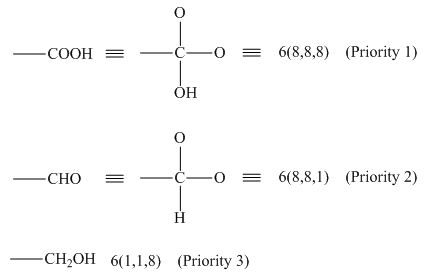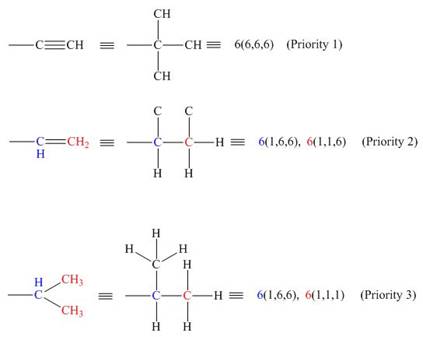
Concept explainers
(a)
Interpretation: The given groups are to be ranked in the order of decreasing priority.
Concept introduction: A carbon atom that has four nonequivalent atoms or groups attached to it is known as chiral carbon atom. Chiral carbon centers are also called as asymmetric or stereogenic centers.
The priorities of the atoms that are directly attached to the stereogenic center are assigned in the order of decreasing
Answer to Problem 5.46P
The decreasing order of priority is
Explanation of Solution
The priority can be assigned by numbering the groups which are bonded to the chiral carbon atom based on the molecular weight and electronegativity.
In the given groups, the atomic number of nitrogen is
The decreasing order of priority for the given groups is
(b)
Interpretation: The given groups are to be ranked in the order of decreasing priority.
Concept introduction: A carbon atom that has four nonequivalent atoms or groups attached to it is known as chiral carbon atom. Chiral carbon centers are also called as asymmetric or stereogenic centers.
The priorities of the atoms that are directly attached to the stereogenic center are assigned in the order of decreasing atomic number. An atom of highest atomic number gets highest priority.
Answer to Problem 5.46P
The decreasing order of priority for the given groups is
Explanation of Solution
The priority can be assigned by numbering the groups which are bonded to the chiral carbon atom based on the molecular weight and electronegativity.
The given groups are
Therefore, the decreasing order of priority for the given groups is
The decreasing order of priority for the given groups is
(c)
Interpretation: The given groups are to be ranked in the order of decreasing priority.
Concept introduction: A carbon atom that has four nonequivalent atoms or groups attached to it is known as chiral carbon atom. Chiral carbon centers are also called as asymmetric or stereogenic centers.
The priorities of the atoms that are directly attached to the stereogenic center are assigned in the order of decreasing atomic number. An atom of highest atomic number gets highest priority.
Answer to Problem 5.46P
The decreasing order of priority is
Explanation of Solution
The priority can be assigned by numbering the groups which are bonded to the chiral carbon atom based on the molecular weight and electronegativity.
In the given groups, the atomic number of nitrogen is
Hence, the decreasing order of priority is
The decreasing order of priority for the given groups is
(d)
Interpretation: The given groups are to be ranked in the order of decreasing priority.
Concept introduction: A carbon atom that has four nonequivalent atoms or groups attached to it is known as chiral carbon atom. Chiral carbon centers are also called as asymmetric or stereogenic centers.
The priorities of the atoms that are directly attached to the stereogenic center are assigned in the order of decreasing atomic number. An atom of highest atomic number gets highest priority.
Answer to Problem 5.46P
The decreasing order of priority is
Explanation of Solution
The priority can be assigned by numbering the groups which are bonded to the chiral carbon atom based on the molecular weight and electronegativity.
In the given groups, the atomic number of carbon is

Figure 1
Hence, the decreasing order of priority is
The decreasing order of priority for the given groups is
(e)
Interpretation: The given groups are to be ranked in the order of decreasing priority.
Concept introduction: A carbon atom that has four nonequivalent atoms or groups attached to it is known as chiral carbon atom. Chiral carbon centers are also called as asymmetric or stereogenic centers.
The priorities of the atoms that are directly attached to the stereogenic center are assigned in the order of decreasing atomic number. An atom of highest atomic number gets highest priority.
Answer to Problem 5.46P
The decreasing order of priority is
Explanation of Solution
The priority can be assigned by numbering the groups which are bonded to the chiral carbon atom based on the molecular weight and electronegativity.
In the given groups, the atomic number of chlorine is
The decreasing order of priority for the given groups is
(f)
Interpretation: The given groups are to be ranked in the order of decreasing priority.
Concept introduction: A carbon atom that has four nonequivalent atoms or groups attached to it is known as chiral carbon atom. Chiral carbon centers are also called as asymmetric or stereogenic centers.
The priorities of the atoms that are directly attached to the stereogenic center are assigned in the order of decreasing atomic number. An atom of highest atomic number gets highest priority.
Answer to Problem 5.46P
The decreasing order of priority for the given groups is
Explanation of Solution
The priority can be assigned by numbering the groups which are bonded to the chiral carbon atom based on the molecular weight and electronegativity.
An atom of highest atomic number gets highest priority. Therefore, in the given groups,
For an atom which is a part of multiple bonds, the priority is assigned by treating the number of multiple bonded atoms equivalent to the number of singly bonded atoms. Among,

Figure 2
Hence, the decreasing order of priority for the given groups is
The decreasing order of priority for the given groups is
Want to see more full solutions like this?
Chapter 5 Solutions
ORGANIC CHEMISTRY
- The electrons flow from the electron-rich atoms of the nucleophile to the electrons poor atoms of the alkyl halide. Identify the electron rich in the nucleophile. Enter the element symbol only, do not include any changes.arrow_forwardHello, I am doing a court case analysis in my Analytical Chemistry course. The case is about a dog napping and my role is prosecution of the defendant. I am tasked in the Area of Expertise in Neutron Activation and Isotopic Analysis. Attached is the following case study reading of my area of expertise! The landscaping stone was not particularly distinctive in its decoration but matched both the color and pattern of the Fluential’s landscaping stone as well as the stone in the back of the recovered vehicle. Further analysis of the stone was done using a technique called instrumental neutron activation analysis. (Proceed to Neutron Activation data) Photo Notes: Landscaping stone recovered in vehicle. Stone at Fluential’s home is similar inappearance. Finally, the white paint on the brick was analyzed using stable isotope analysis. The brick recovered at the scene had smeared white paint on it. A couple of pieces of brick in the back of the car had white paint on them. They…arrow_forwardCite the stability criteria of an enamine..arrow_forward
- What would you expect to be the major product obtained from the following reaction? Please explain what is happening here. Provide a detailed explanation and a drawing showing how the reaction occurs. The correct answer to this question is V.arrow_forwardPlease answer the question for the reactions, thank youarrow_forwardWhat is the product of the following reaction? Please include a detailed explanation of what is happening in this question. Include a drawing showing how the reagent is reacting with the catalyst to produce the correct product. The correct answer is IV.arrow_forward
- Please complete the reactions, thank youarrow_forwardConsider the synthesis. What is compound Y? Please explain what is happening in this question. Provide a detailed explanation and a drawing to show how the compound Y creates the product. The correct answer is D.arrow_forwardWhat would be the major product of the following reaction? Please include a detailed explanation of what is happening in this question. Include steps and a drawing to show this reaction proceeds and how the final product is formed. The correct answer is B. I put answer D and I don't really understand what is going on in the question.arrow_forward
 ChemistryChemistryISBN:9781305957404Author:Steven S. Zumdahl, Susan A. Zumdahl, Donald J. DeCostePublisher:Cengage Learning
ChemistryChemistryISBN:9781305957404Author:Steven S. Zumdahl, Susan A. Zumdahl, Donald J. DeCostePublisher:Cengage Learning ChemistryChemistryISBN:9781259911156Author:Raymond Chang Dr., Jason Overby ProfessorPublisher:McGraw-Hill Education
ChemistryChemistryISBN:9781259911156Author:Raymond Chang Dr., Jason Overby ProfessorPublisher:McGraw-Hill Education Principles of Instrumental AnalysisChemistryISBN:9781305577213Author:Douglas A. Skoog, F. James Holler, Stanley R. CrouchPublisher:Cengage Learning
Principles of Instrumental AnalysisChemistryISBN:9781305577213Author:Douglas A. Skoog, F. James Holler, Stanley R. CrouchPublisher:Cengage Learning Organic ChemistryChemistryISBN:9780078021558Author:Janice Gorzynski Smith Dr.Publisher:McGraw-Hill Education
Organic ChemistryChemistryISBN:9780078021558Author:Janice Gorzynski Smith Dr.Publisher:McGraw-Hill Education Chemistry: Principles and ReactionsChemistryISBN:9781305079373Author:William L. Masterton, Cecile N. HurleyPublisher:Cengage Learning
Chemistry: Principles and ReactionsChemistryISBN:9781305079373Author:William L. Masterton, Cecile N. HurleyPublisher:Cengage Learning Elementary Principles of Chemical Processes, Bind...ChemistryISBN:9781118431221Author:Richard M. Felder, Ronald W. Rousseau, Lisa G. BullardPublisher:WILEY
Elementary Principles of Chemical Processes, Bind...ChemistryISBN:9781118431221Author:Richard M. Felder, Ronald W. Rousseau, Lisa G. BullardPublisher:WILEY





